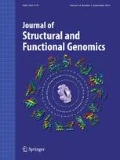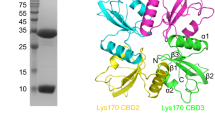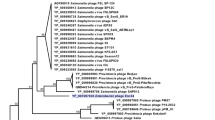Abstract
Phage viruses that infect prokaryotes integrate their genome into the host chromosome; thus, microbial genomes typically contain genetic remnants of both recent and ancient phage infections. Often phage genes occur in clusters of atypical G+C content that reflect integration of the foreign DNA. However, some phage genes occur in isolation without other phage gene neighbors, probably resulting from horizontal gene transfer. In these cases, the phage gene product is unlikely to function as a component of a mature phage particle, and instead may have been co-opted by the host for its own benefit. The product of one such gene from Salmonella enterica serovar Typhimurium, STM3605, encodes a protein with modest sequence similarity to phage-like lysozyme (N-acetylmuramidase) but appears to lack essential catalytic residues that are strictly conserved in all lysozymes. Close homologs in other bacteria share this characteristic. The structure of the STM3605 protein was characterized by X-ray crystallography, and functional assays showed that it is a stable, folded protein whose structure closely resembles lysozyme. However, this protein is unlikely to hydrolyze peptidoglycan. Instead, STM3605 is presumed to have evolved an alternative function because it shows some lytic activity and partitions to micelles.







Similar content being viewed by others
Abbreviations
- Rmsd:
-
Root-mean-square deviation
- SAD:
-
Single-wavelength anomalous diffraction
- SVM:
-
Support vector machine
- PDB:
-
Protein Data Bank
References
Young I, Wang I (2000) Roof WD: phages will out: strategies of host cell lysis. Trends Microbiol 8(3):120–128
Jacob F, Fuerst CR (1958) The mechanism of lysis by phage studied with defective lysogenic bacteria. J Gen Microbiol 18(2):518–526
Kanamaru S, Ishiwata Y, Suzuki T, Rossmann MG, Arisaka F (2005) Control of bacteriophage T4 tail lysozyme activity during the infection process. J Mol Biol 346(4):1013–1020
Loessner MJ (2005) Bacteriophage endolysins–current state of research and applications. Curr Opin Microbiol 8(4):480–487
Borysowski J, Weber-Dabrowska B, Gorski A (2006) Bacteriophage endolysins as a novel class of antibacterial agents. Exp Biol Med (Maywood) 231(4):366–377
McClelland M, Sanderson KE, Spieth J, Clifton SW, Latreille P, Courtney L, Porwollik S, Ali J, Dante M, Du F et al (2001) Complete genome sequence of Salmonella enterica serovar Typhimurium LT2. Nature 413(6858):852–856
Petersen TN, Brunak S, von Heijne G, Nielsen H (2011) SignalP 4.0: discriminating signal peptides from transmembrane regions. Nat Methods 8(10):785–786
Kall L, Krogh A, Sonnhammer EL (2004) a combined transmembrane topology and signal peptide prediction method. J Mol Biol 338(5):1027–1036
Galan JE, Wolf-Watz H (2006) Protein delivery into eukaryotic cells by type III secretion machines. Nature 444(7119):567–573
Samudrala R, Heffron F, McDermott JE (2009) Accurate prediction of secreted substrates and identification of a conserved putative secretion signal for type III secretion systems. PLoS Pathog 5(4):e1000375
McDermott JE, Corrigan A, Peterson E, Oehmen C, Niemann G, Cambronne ED, Sharp D, Adkins JN, Samudrala R, Heffron F (2011) Computational prediction of type III and IV secreted effectors in gram-negative bacteria. Infect Immun 79(1):23–32
Jehl MA, Arnold R, Rattei T (2011) Effective–a database of predicted secreted bacterial proteins. Nucleic Acids Res 39(Database issue):D591–D595
Zhang X, Studier FW (2004) Multiple roles of T7 RNA polymerase and T7 lysozyme during bacteriophage T7 infection. J Mol Biol 340(4):707–730
Kim Y, Babnigg G, Jedrzejczak R, Eschenfeldt WH, Li H, Maltseva N, Hatzos-Skintges C, Gu M, Makowska-Grzyska M, Wu R et al (2011) High-throughput protein purification and quality assessment for crystallization. Methods 55(1):12–28
Klock HE, Lesley SA (2009) The polymerase incomplete primer extension (PIPE) method applied to high-throughput cloning and site-directed mutagenesis. Methods Mol Biol 498:91–103
Dieckman L, Gu M, Stols L, Donnelly MI, Collart FR (2002) High throughput methods for gene cloning and expression. Protein Expr Purif 25(1):1–7
Donnelly MI, Zhou M, Millard CS, Clancy S, Stols L, Eschenfeldt WH, Collart FR, Joachimiak A (2006) An expression vector tailored for large-scale, high-throughput purification of recombinant proteins. Protein Expr Purif 47(2):446–454
Kim Y, Quartey P, Li H, Volkart L, Hatzos C, Chang C, Nocek B, Cuff M, Osipiuk J, Tan K et al (2008) Large-scale evaluation of protein reductive methylation for improving protein crystallization. Nat Methods 5(10):853–854
Minor W, Cymborowski M, Otwinowski Z, Chruszcz M (2006) HKL-3000: the integration of data reduction and structure solution–from diffraction images to an initial model in minutes. Acta Crystallogr D Biol Crystallogr 62(Pt 8):859–866
French S, Wilson K (1978) Treatment of negative intensity observations. Acta Crystallogr A 34:517–525
Winn MD, Ballard CC, Cowtan KD, Dodson EJ, Emsley P, Evans PR, Keegan RM, Krissinel EB, Leslie AG, McCoy A et al (2011) Overview of the CCP4 suite and current developments. Acta Crystallogr D Biol Crystallogr 67(Pt 4):235–242
Langer G, Cohen SX, Lamzin VS, Perrakis A (2008) Automated macromolecular model building for X-ray crystallography using ARP/wARP version 7. Nature Protoc 3(7):1171–1179
Emsley P, Cowtan K (2004) Coot: model-building tools for molecular graphics. Acta Crystallogr D Biol Crystallogr 60(Pt 12 Pt 1):2126–2132
Bricogne G, Blanc E, Brandl M, Flensburg C, Keller P, Paciorek W, Roversi P, Sharff A, Smart OS, Vonrhein C et al (2011) BUSTER version 2.10.0. Global Phasing Ltd, Cambridge
Quevillon E, Silventoinen V, Pillai S, Harte N, Mulder N, Apweiler R, Lopez R (2005) InterProScan: protein domains identifier. Nucleic Acids Res 33(Web Server issue):W116–W120
Cuff AL, Sillitoe I, Lewis T, Clegg AB, Rentzsch R, Furnham N, Pellegrini-Calace M, Jones D, Thornton J, Orengo CA (2011) Extending CATH: increasing coverage of the protein structure universe and linking structure with function. Nucleic Acids Res 39(Database issue):D420–D426
Holm L, Rosenstrom P (2010) Dali server: conservation mapping in 3D. Nucleic Acids Res 38(Web Server issue):W545–W549
Laskowski RA, Watson JD, Thornton JM (2005) ProFunc a server for predicting protein function from 3D structure. Nucleic Acids Res 33(Web Server issue):W89–W93
Krissinel E, Henrick K (2007) Inference of macromolecular assemblies from crystalline state. J Mol Biol 372(3):774–797
Anand NN, Stephen ER, Narang SA (1988) Mutation of active-site residues in synthetic T4-lysozyme gene and their effect on lytic activity. Biochem Biophys Res Commun 153(2):862–868
Malcolm BA, Rosenberg S, Corey MJ, Allen JS, de Baetselier A, Kirsch JF (1989) Site-directed mutagenesis of the catalytic residues Asp-52 and Glu-35 of chicken egg white lysozyme. Proc Natl Acad Sci USA 86(1):133–137
Weaver LH, Grutter MG, Matthews BW (1995) The refined structures of goose lysozyme and its complex with a bound trisaccharide show that the “goose-type” lysozymes lack a catalytic aspartate residue. J Mol Biol 245(1):54–68
Rennell D, Bouvier SE, Hardy LW, Poteete AR (1991) Systematic mutation of bacteriophage-T4 Lysozyme. J Mol Biol 222(1):67–87
Kuroki R, Weaver LH, Matthews BW (1993) A covalent enzyme-substrate intermediate with saccharide distortion in a mutant T4 lysozyme. Science 262(5142):2030–2033
During K, Porsch P, Mahn A, Brinkmann O, Gieffers W (1999) The non-enzymatic microbicidal activity of lysozymes. FEBS Lett 449(2–3):93–100
Orito Y, Morita M, Hori K, Unno H, Tanji Y (2004) Bacillus amyloliquefaciens phage endolysin can enhance permeability of Pseudomonas aeruginosa outer membrane and induce cell lysis. Appl Microbiol Biotechnol 65(1):105–109
de la Vara LEG, Alfaro BL (2009) Separation of membrane proteins according to their hydropathy by serial phase partitioning with Triton X-114. Anal Biochem 387((2):280–286
Young R, Blasi U (1995) Holins: form and function in bacteriophage lysis. FEMS Microbiol Rev 17(1–2):191–205
Wang IN, Smith DL, Young R (2000) Holins: the protein clocks of bacteriophage infections. Annu Rev Microbiol 54:799–825
Yeaman MR, Yount NY (2003) Mechanisms of antimicrobial peptide action and resistance. Pharmacol Rev 55(1):27–55
Hautefort I, Thompson A, Eriksson-Ygberg S, Parker ML, Lucchini S, Danino V, Bongaerts RJ, Ahmad N, Rhen M, Hinton JC (2008) During infection of epithelial cells Salmonella enterica serovar Typhimurium undergoes a time-dependent transcriptional adaptation that results in simultaneous expression of three type 3 secretion systems. Cell Microbiol 10(4):958–984
Grimm F, Cort JR, Dahl C (2010) DsrR, a novel IscA-like protein lacking iron- and Fe-S-binding functions, involved in the regulation of sulfur oxidation in Allochromatium vinosum. J Bacteriol 192(6):1652–1661
Laskowski RA (1995) SURFNET: a program for visualizing molecular surfaces, cavities, and intermolecular interactions. J Mol Graph 13(5):323–330, 307–328
Acknowledgments
The authors would like to thank the members of the Midwest Center for Structural Biology and Structural Biology Center for their support. This research has been funded in part by a grant from the National Institutes of Health GM094585 (AJ), GM094623 (JNA), and by the US Department of Energy, Office of Biological and Environmental Research, under Contract DE-AC02-06CH11357. The authors wish to thank Gekleng Chhor for proofreading of this manuscript.
Author information
Authors and Affiliations
Corresponding authors
Additional information
The submitted manuscript has been created by UChicago Argonne, LLC, Operator of Argonne National Laboratory (“Argonne”). Argonne, a US Department of Energy Office of Science laboratory, is operated under Contract No. DE-AC02-06CH11357. The US Government retains for itself, and others acting on its behalf, a paid-up nonexclusive, irrevocable worldwide license in said article to reproduce, prepare derivative works, distribute copies to the public, and perform publicly and display publicly, by or on behalf of the Government.
Rights and permissions
About this article
Cite this article
Michalska, K., Brown, R.N., Li, H. et al. New sub-family of lysozyme-like proteins shows no catalytic activity: crystallographic and biochemical study of STM3605 protein from Salmonella Typhimurium. J Struct Funct Genomics 14, 1–10 (2013). https://doi.org/10.1007/s10969-013-9151-0
Received:
Accepted:
Published:
Issue Date:
DOI: https://doi.org/10.1007/s10969-013-9151-0




